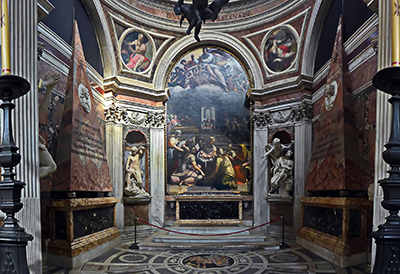The Chigi Chapel is the religious building designed by Raphael that has been preserved in its almost original form. It's an Italian Renaissance plus Baroque art treasure trove and ranked as one of the most prominent monuments in the basilica.
The use of rare, expensive stones all over this chapel is an essential characteristic that invokes the Pantheon's interior, which was Raphael's main source of inspiration. He was aware the ancients were using more precious materials compared to contemporary Renaissance architects, and he intended to follow their example.
As a painter, he was typically attracted to the bright colours of the different types of stones that were available in the city of Rome since the antiquity. Agostino Chigi, who was his patron, was among the few people who were rich enough to finance projects aiming to recreate the chromatic ebullience of ancient architecture, which was largely lost. At Raphael era, the chapel's coloured revetment was a total novelty in Rome; it remained rare until 1578 to1580 when the Cappella Gregoriana in Papal Basilica of St. Peter in the Vatican was decorated. However, during the era of Baroque, using coloured marbles became common.
The centralised plan of Raphael was inspired by Bramante designs for the new Papal Basilica of St. Peter in the Vatican (St. Peter's Basilica). The Pantheon was also another source of inspiration with its Corinthian pilasters, marble revetments and dome. A hemispherical dome surmounts the simple cube and rests on a high drum penetrated by windows that lets light into the building. The trapezoidal pendentives were Bramante characteristics, but the entire conception of space, which needs the observer to look at from various points of view if they want to capture its magnificence, is new plus unique.
The cornice and the entablature are decorated with bead-and-reel, egg-and-dart plus flower-patterned enrichments. Also, the pilasters of the chapel are made of white Carrara polished marble. A coloured marble revetment covers the surfaces between these pilasters, and white marble panels divide their slabs. The side walls have round-headed arches; the entrance arch is the only one that's open. The other arches are blind and alternated with canted corners where shell-headed niches have been framed between Corinthian pilasters.
The arches' surfaces are finished with Renaissance ornaments. The inner arch's archivolt is decorated with a mask and rich garlands of fruits. In the inner arch's intrados, there is a central band of rectangles and rosettes with grotesques, which is framed by 2 interlacement bands with 6 pointed stars in the centre. The outer arch's intrados has a meander. The friezes in Chigi Chapel are uniquely dropped between the capitals. That was an uncommon thing and Raphael gave it a whole new significance with the ebullience and pliability of the carvings.
A marble railing marks the chapel's entrance. It's made of a giallo antico marble frame (yellow in colour) with portasanta balusters (dark red). The railing was made larger, and in the seventeenth century, the turgid balusters were also added. The step that leads to the Chigi Chapel is a large Egyptian granite monolith. The central wooden door panels are decorated with a thick foliage of sculpted acanthus leaves.
The exterior of this chapel is simple. Its severe appearance and simplicity were based on the ancient Roman central-plan buildings reception. The cube (oblong in shape) of exposed brick is surmounted by the cylindric tambour pierced with big rectangular windows. The tambour is finished with a beautiful brick modillion trim and the cube is decorated with a stone cornice. The low conical roof of the building is covered with tiles: it was originally covered with lead. The dome of the chapel is crowned by a tiny stone lanternino with niches rather than windows between the Tuscan pilasters; its base is finished with 4 scrolls. The miniature round temple has been topped with the Chigi family symbols, the mountains and star with a cross.




